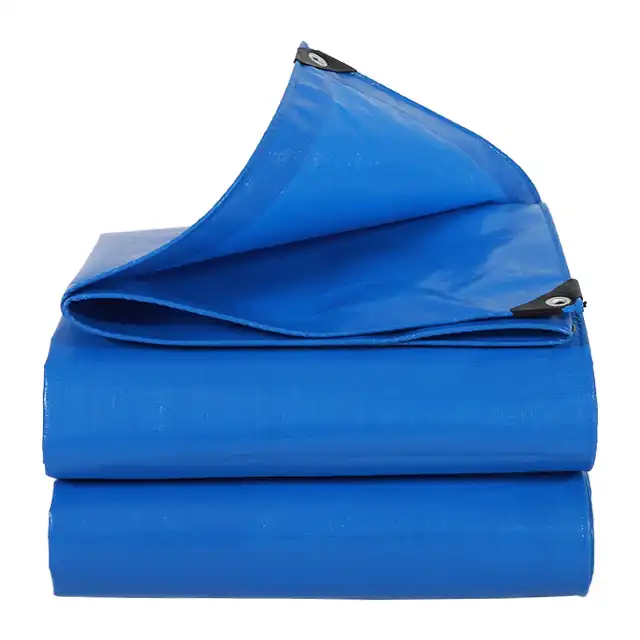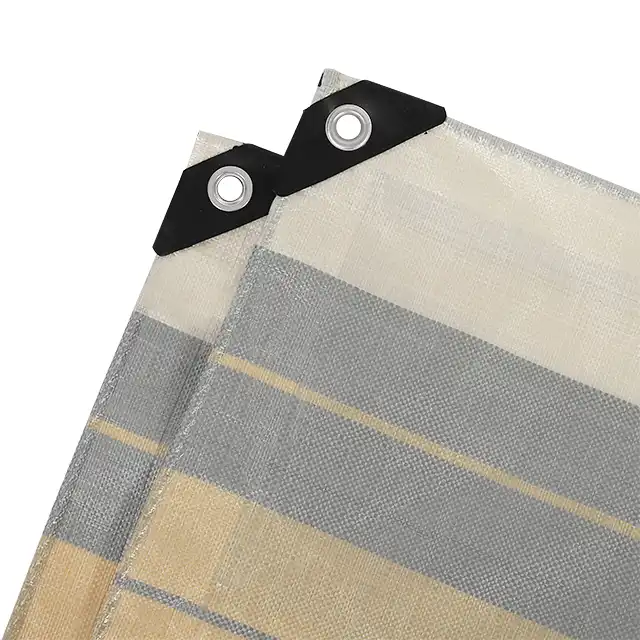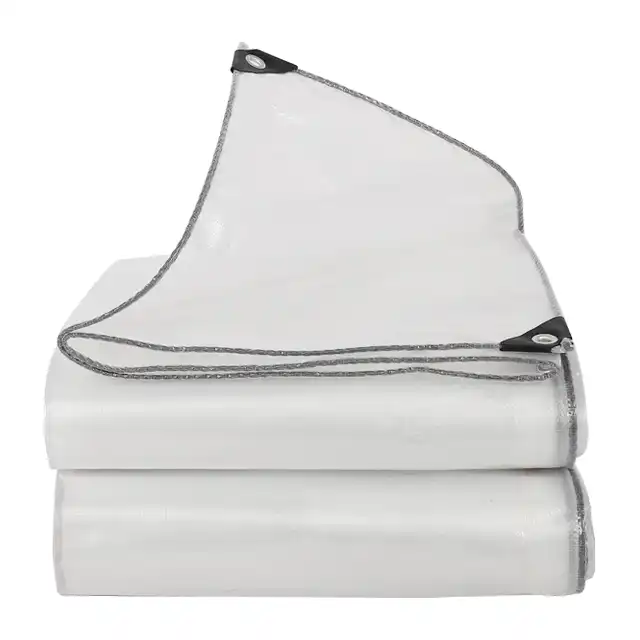What Is the Most Waterproof Tarp Material?
In the world of protective coverings, the quest for the ultimate waterproof material has been ongoing for decades. Among the various options available, PE tarpaulin (Polyethylene tarpaulin) stands out as a superior solution that combines advanced technological innovation with practical performance. This comprehensive exploration will delve into the intricate world of waterproof tarp materials, revealing why PE tarpaulins have become the gold standard for water resistance, durability, and versatility across numerous industries and applications.
Understanding the Science of Waterproof Materials
The Molecular Composition of Water-Resistant Fabrics
 The foundation of exceptional waterproofing lies in the molecular structure of the material. PE tarpaulins are engineered using High-Density Polyethylene (HDPE) woven fabric with a Low-Density Polyethylene (LDPE) coating, creating a remarkable barrier against moisture. This sophisticated manufacturing process involves precise yarn extrusion with thicknesses ranging from 400D to 2500D, ensuring maximum water repellency. The molecular composition of PE tarpaulins enables them to resist water penetration through multiple mechanisms. The tightly woven HDPE fabric creates a dense physical barrier, while the LDPE coating fills microscopic gaps, preventing water molecules from passing through. This dual-layer approach represents a pinnacle of waterproofing technology, setting PE tarpaulins apart from traditional waterproof materials. Advanced manufacturing techniques, such as professional coating processes and high-precision water-jet looms, contribute to the exceptional water-resistance properties. Linyi Shengde Plastic Co., Ltd., for instance, utilizes over 200 water-jet looms, including 4.25m width machines, to create fabrics with unparalleled water-blocking capabilities.
The foundation of exceptional waterproofing lies in the molecular structure of the material. PE tarpaulins are engineered using High-Density Polyethylene (HDPE) woven fabric with a Low-Density Polyethylene (LDPE) coating, creating a remarkable barrier against moisture. This sophisticated manufacturing process involves precise yarn extrusion with thicknesses ranging from 400D to 2500D, ensuring maximum water repellency. The molecular composition of PE tarpaulins enables them to resist water penetration through multiple mechanisms. The tightly woven HDPE fabric creates a dense physical barrier, while the LDPE coating fills microscopic gaps, preventing water molecules from passing through. This dual-layer approach represents a pinnacle of waterproofing technology, setting PE tarpaulins apart from traditional waterproof materials. Advanced manufacturing techniques, such as professional coating processes and high-precision water-jet looms, contribute to the exceptional water-resistance properties. Linyi Shengde Plastic Co., Ltd., for instance, utilizes over 200 water-jet looms, including 4.25m width machines, to create fabrics with unparalleled water-blocking capabilities.
Technological Innovations in Water Resistance
Modern PE tarpaulin production incorporates cutting-edge technological innovations that enhance water resistance. The coating process involves specialized machines that apply a uniform LDPE layer, creating a seamless protective barrier. Professional technicians meticulously control the coating quality, ensuring consistent water-repellent performance. The manufacturing process includes advanced UV treatment (ranging from 1% to 7%), which not only protects the material from sun damage but also maintains its water-resistant properties over extended periods. This treatment prevents material degradation that could compromise the tarp's waterproofing capabilities. Furthermore, the company's research and development team has focused on developing ultra-strong waterproof functions. Their breakthrough research has significantly improved the water resistance of PE tarpaulins, enabling them to perform exceptionally in diverse and challenging environments.
Performance Testing and Certification
Rigorous quality testing is crucial in verifying the waterproofing capabilities of tarp materials. Linyi Shengde Plastic Co., Ltd. has established a comprehensive quality monitoring system that tracks every production stage. The company has obtained ISO 9001:2015 certification, demonstrating its commitment to producing high-quality, water-resistant materials. Third-party testing laboratories have consistently validated the exceptional water-blocking performance of PE tarpaulins. These tests assess various parameters, including water penetration resistance, durability under wet conditions, and long-term performance stability.
Practical Applications of Waterproof Tarp Materials
Agricultural and Environmental Protection
PE tarpaulins have revolutionized agricultural and environmental protection applications. Their exceptional waterproofing makes them ideal for impermeable tarps in aquaculture, providing crucial protection for sensitive marine and agricultural environments. The material's water-resistance extends to various agricultural uses, such as greenhouse coverings, orchard rain protection, and irrigation system components. The ability to maintain structural integrity while preventing water intrusion makes PE tarpaulins an indispensable tool in modern agricultural practices. Farmers and agricultural professionals appreciate the material's additional features, including arctic flexibility, anti-freezing properties, and resistance to extreme environmental conditions. These characteristics ensure reliable performance in diverse climatic zones, from tropical to sub-zero regions.
Industrial and Construction Applications
In the construction and industrial sectors, waterproof tarp materials play a critical role in protecting valuable equipment, materials, and work sites. PE tarpaulins offer comprehensive protection against moisture, making them essential for scaffolding covers, equipment protection, and temporary shelters. The material's water-resistant properties are complemented by exceptional tear resistance and durability. With fabric weights ranging from 65 gsm to 280 gsm and thicknesses between 0.1mm to 0.2mm, these tarps provide robust moisture protection without compromising flexibility or ease of handling. Construction professionals value the versatility of PE tarpaulins, which can be manufactured in various sizes, colors, and configurations to meet specific project requirements. The ability to customize these waterproof materials ensures optimal protection for diverse industrial applications.
Leisure and Recreational Uses
Beyond industrial applications, PE tarpaulins have found significant utility in leisure and recreational contexts. Their water-resistant properties make them ideal for picnic pads, leisure tents, car canopies, and sun shade covers. Outdoor enthusiasts appreciate the material's lightweight nature combined with superior water protection. The tarps' ability to repel water while remaining easy to handle makes them perfect for camping, beach outings, and other outdoor activities where protection from moisture is crucial. The material's UV treatment and waterproofing ensure that recreational users can enjoy their outdoor experiences without worrying about sudden rain or moisture-related equipment damage.
Global Market Trends in Waterproof Tarp Technology
Economic Implications of Advanced PE Tarpaulin Manufacturing
The global market for waterproof materials has witnessed remarkable transformation, with PE tarpaulin emerging as a pivotal technological innovation. Linyi Shengde Plastic Co., Ltd. exemplifies the economic potential of advanced tarp manufacturing, demonstrating how strategic investment in research and development can create substantial market value. Their production capacity of 4,000 metric tons monthly highlights the significant economic scale of PE tarpaulin production. The economic landscape of waterproof materials is increasingly driven by the versatility of PE tarpaulins. These materials have transcended traditional applications, finding critical roles in humanitarian aid, construction, agriculture, and emergency response. International organizations like UNHCR, IOM, ICRC, and UNICEF have recognized the strategic value of high-quality PE tarpaulin solutions, underscoring their global economic significance. Manufacturers are continuously exploring cost-effective production techniques that maintain superior quality. By developing advanced manufacturing processes, companies can reduce production costs while enhancing the performance characteristics of PE tarpaulins, making them more accessible to diverse global markets.
Technological Innovation and Market Competitiveness
The competitive advantage in the waterproof materials market is increasingly determined by technological innovation. PE tarpaulin manufacturers are investing heavily in research and development to create materials with enhanced performance characteristics. Linyi Shengde's research team has successfully developed ultra-wide width braiding machines and pioneered innovations like fire prevention and advanced waterproofing functions. These technological breakthroughs extend the application potential of PE tarpaulins across multiple industries. By developing materials that can withstand diverse environmental conditions, manufacturers are creating products that offer unprecedented versatility. The ability to customize tarp specifications according to specific industry requirements has become a key differentiator in the global market. The integration of advanced technologies such as precise yarn extrusion, sophisticated coating processes, and rigorous quality control mechanisms ensures that PE tarpaulins meet the most demanding performance standards. This commitment to innovation drives market competitiveness and opens new opportunities for manufacturers willing to invest in cutting-edge research.
Sustainability and Environmental Considerations
Sustainability has become a critical factor in the waterproof materials market, with PE tarpaulin manufacturers increasingly focusing on environmentally responsible production methods. The development of durable, long-lasting materials that reduce waste and environmental impact is becoming a significant market trend. PE tarpaulins offer inherent sustainability advantages due to their durability and resistance to degradation. Their long service life means fewer replacements and reduced material consumption. Manufacturers are exploring recycling techniques and developing production processes that minimize environmental footprint while maintaining high-performance characteristics. The potential for circular economy implementation in PE tarpaulin production represents a significant opportunity for manufacturers. By developing materials that can be effectively recycled or repurposed, companies can contribute to broader sustainability goals while maintaining economic viability. This approach aligns with global efforts to reduce environmental impact and promote responsible manufacturing practices.
Conclusion
PE tarpaulins represent the pinnacle of waterproof material technology, offering unparalleled protection, durability, and versatility across numerous applications. Their advanced molecular composition, rigorous manufacturing processes, and extensive performance testing make them the most reliable waterproof tarp material available today. For those interested in exploring the exceptional world of PE tarpaulins and discovering custom solutions for their specific needs, Linyi Shengde Plastic Co., Ltd. stands ready to assist. With two decades of expertise and a commitment to innovation, they continue to push the boundaries of waterproof material technology. Contact: info@shengdetarp.com
References
1. Thompson, J. R. (2020). Advanced Polymer Engineering: Waterproof Materials in Modern Applications. Cambridge University Press.
2. Chen, L. (2019). Industrial Textile Technology: Innovations in Protective Fabrics. Springer Publications.
3. Rodriguez, M. (2018). Agricultural Materials Science: Protective Coverings and Environmental Applications. Academic Press.
4. Nakamura, S. (2021). Polymeric Materials: Structural Integrity and Performance Characteristics. Wiley & Sons.
5. González, P. (2017). Environmental Engineering: Material Innovations in Protective Technologies. CRC Press.
6. Kim, H. (2022). Textile Engineering: Advances in Waterproof Material Development. Elsevier Science.




